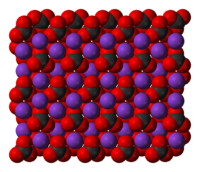Pearlash
 |
|
 |
|
 |
|
| Names | |
|---|---|
|
IUPAC name
Potassium carbonate
|
|
| Other names
Carbonate of potash, Dipotassium carbonate, Sub-carbonate of potash, Pearl ash, Potash, Salt of tartar, Salt of wormwood.
|
|
| Identifiers | |
|
3D model (JSmol)
|
|
| ChEBI | |
| ChemSpider | |
| ECHA InfoCard | 100.008.665 |
| E number | E501 (acidity regulators, ...) |
|
PubChem CID
|
|
| RTECS number | TS7750000 |
| UNII | |
|
|
|
|
| Properties | |
| K2CO3 | |
| Molar mass | 138.205 g/mol |
| Appearance | white, hygroscopic solid |
| Density | 2.43 g/cm3 |
| Melting point | 891 °C (1,636 °F; 1,164 K) |
| Boiling point | decomposes |
| 112 g/100 mL (20 °C) 156 g/100 mL (100 °C) |
|
| Solubility | 3.11 g/100 mL (25 °C) Methanol insoluble in alcohol, acetone |
| −59.0·10−6 cm3/mol | |
| Hazards | |
| Safety data sheet | ICSC 1588 |
| GHS pictograms |  |
| GHS signal word | Warning |
| H302, H315, H319, H335 | |
| P261, P305+351+338 | |
| NFPA 704 | |
| Flash point | Non-flammable |
| Lethal dose or concentration (LD, LC): | |
|
LD50 (median dose)
|
1870 mg/kg (oral, rat) |
| Related compounds | |
|
Other anions
|
Potassium bicarbonate |
|
Other cations
|
Lithium carbonate Sodium carbonate Rubidium carbonate Caesium carbonate |
|
Related compounds
|
Ammonium carbonate |
|
Except where otherwise noted, data are given for materials in their standard state (at 25 °C [77 °F], 100 kPa).
|
|
|
|
|
| Infobox references | |
Potassium carbonate (K2CO3) is a white salt, soluble in water (insoluble in ethanol) which forms a strongly alkaline solution. It can be made as the product of potassium hydroxide's absorbent reaction with carbon dioxide. It is deliquescent, often appearing a damp or wet solid. Potassium carbonate is used in the production of soap and glass.
Potassium carbonate is the primary component of potash and the more refined pearl ash or salts of tartar. Historically, pearl ash was created by baking potash in a kiln to remove impurities. The fine, white powder remaining was the pearl ash. The first patent issued by the US Patent Office was awarded to Samuel Hopkins in 1790 for an improved method of making potash and pearl ash.
In late 18th century North America, before the development of baking powder, pearl ash was used as a leavening agent in quick breads.
Today, potassium carbonate is prepared commercially by the electrolysis of potassium chloride. The resulting potassium hydroxide is then carbonated using carbon dioxide to form potassium carbonate, which is often used to produce other Potassium compounds.
...
Wikipedia

